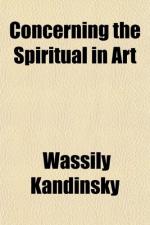FIGURE II
Second Pair of antitheses (physical appeal of complementary C and D colours)
C. Red Green = Third antithesis
Movement
of the spiritually extinguished
First
antithesis
Motion within itself [circle] = Potentiality
of motion
=
Motionlessness
Red
Ex-and concentric movements are absent
In
optical blend = Gray
In mechanical blend of white and black = Gray
D. Orange Violet = Fourth antithesis
Arise out of the first antithesis from:
1. Active element of the yellow in red = Orange 2. Passive element of the blue in red = Violet
<—–Orange—–Yellow<
;—<—<—Red—>—>—>Blue—–Violet—–>
In excentric Motion within In Concentric direction itself direction
As in a great circle, a serpent biting its own tail (the symbol of eternity, of something without end) the six colours appear that make up the three main antitheses. And to right and left stand the two great possibilities of silence—death and birth (see Fig. 3).
FIGURE III.
A Yellow / \ / \ / \ D C B Orange Green B White | | Black | | | | C D Red Violet \ / \ / \ A / Blue
The antitheses as a circle between two poles, i.e., the life of colours between birth and death.
(The capital letters designate the pairs of antitheses.)
It is clear that all I have said of these simple colours is very provisional and general, and so also are those feelings (joy, grief, etc.) which have been quoted as parallels of the colours. For these feelings are only the material expressions of the soul. Shades of colour, like those of sound, are of a much finer texture and awake in the soul emotions too fine to be expressed in words. Certainly each tone will find some probable expression in words, but it will always be incomplete, and that part which the word fails to express will not be unimportant but rather the very kernel of its existence. For this reason words are, and will always remain, only hints, mere suggestions of colours. In this impossibility of expressing colour in words with the consequent need for some other mode of expression lies the opportunity of the art of the future. In this art among innumerable rich and varied combinations there is one which is founded on firm fact, and that is as follows. The actual expression of colour can be achieved simultaneously by several forms of art, each art playing its separate part, and producing a whole which exceeds in richness and force any expression attainable by one art alone. The immense possibilities of depth and strength to be gained by combination or by discord between the various arts can be easily realized.




